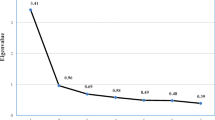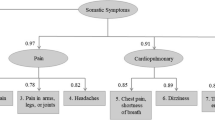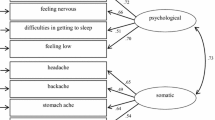Abstract
The psychological health of children is a global health concern. The international Health Behavior in School-Aged Children (HBSC) study has surveyed the psychological health of youths in over 40 countries. The HBSC questionnaire includes a brief symptom checklist of psychological complaints, but it has not yet been validated. This study evaluated the construct validity of the psychological health self-report tool used in the HBSC study. We used data from 26,078 participants in the 2010 Canadian HBSC survey. The core HBSC questionnaire measured common psychosomatic complaints using the HBSC symptom checklist (HBSC-SCL). The Canadian survey included an additional series of questions that measure four dimensions of mental health (emotional problems, emotional well-being, behavioral problems, prosocial behavior). We used these items to evaluate the construct validity of psychological symptoms in the HBSC-SCL. We assessed internal construct validity using Cronbach’s alpha and external construct validity using factor analysis and structural equation modelling. Factor analysis showed that the HBSC-SCL measures two factors, psychological and somatic complaints. Psychological complaints included feeling low/depressed, irritable/bad tempered, nervous, and difficulties sleeping. Internal validity of the psychological subscale was good (α = 0.78). This 4-item subscale demonstrated convergent validity with indicators for emotional problems (correlation (r) = −0.79, p < 0.001) and emotional well-being (r = 0.48, p < 0.001), and discriminant validity with indicators for behavioral problems (r = −0.17, p < 0.001) and prosocial behavior (r = 0.02, p < 0.001). Results support the HBSC-SCL psychological subscale as a valid measure of psychological health in school-aged children. Future research is recommended to replicate findings in other youth populations.

Similar content being viewed by others
Abbreviations
- α:
-
Cronbach’s alpha
- β:
-
Regression coefficient
- CD:
-
Coefficient of determination
- CFI:
-
Comparative fit index
- HBSC:
-
Health behavior in school-aged children
- HBSC-SCL:
-
Health behavior in school-aged children symptom checklist
- r:
-
Pearson correlation coefficient
- RMSEA:
-
Root mean square error of approximation
- SEM:
-
Structural equation modelling
- SMRM:
-
Standardized root mean square residual
- TLI:
-
Tucker–Lewis index
- WHO:
-
World health organization
References
Boyce, W. F., Davies, D., Raman, S. R., Tynjala, J., Valimaa, R., King, M., et al. (2009). Emotional health of Canadian and Finnish students with disabilities or chronic conditions. [Article]. International Journal of Rehabilitation Research, 32(2), 154–161. doi:10.1097/MRR.0b013e32831e452e.
Currie CE, G. R., Theunissen, A., Molcho, M., Samdal, O., & Dur, W. (2010). Health behaviour in school-aged children (HBSC) study protocol: Background, methodology and mandatory items for the 2009/10 survey. Edinburgh: University of Edinburgh.
Damsgaard, M. T., Holstein, B. E., Koushede, V., Madsen, K. R., Meilstrup, C., Nelausen, M. K., et al. (2014). Close relations to parents and emotional symptoms among adolescents: beyond socio-economic impact? [Article]. International Journal of Public Health, 59(5), 721–726. doi:10.1007/s00038-014-0600-8.
de Matos, M. G., Barrett, P., Dadds, M., & Shortt, A. (2003). Anxiety, depression, and peer relationships during adolescence: results from the Portuguese national health behaviour in school-aged children survey. [Article]. European Journal of Psychology of Education, 18(1), 3–14.
Elgar, F. J., Craig, W., & Trites, S. J. (2013). Family dinners, communication, and mental health in Canadian adolescents. [Article]. Journal of Adolescent Health, 52(4), 433–438. doi:10.1016/j.jadohealth.2012.07.012.
Ferrari, A. J., Charlson, F. J., Norman, R. E., Patten, S. B., Freedman, G., Murray, C. J. L., et al. (2013). Burden of depressive disorders by country, sex, age, and year: findings from the global burden of disease study 2010. PLoS Medicine, 10(11), e1001547. doi:10.1371/journal.pmed.1001547.
Freeman, J. G., King, M., Pickett, W., Craig, W., Elgar, F., Janssen, I., et al. (2012). The health of Canada’s young people: A mental health focus (pp. 11–28). Ottawa: Health Canada.
Haugland, S., & Wold, B. (2001). Subjective health complaints in adolescence - reliability and validity of survey methods. [Article]. Journal of Adolescence, 24(5), 611–624. doi:10.1006/jado.2000.0393.
Haugland, S., Wold, B., Stevenson, J., Aaroe, L. E., & Woynarowska, B. (2001). Subjective health complaints in adolescence - a cross-national comparison of prevalence and dimensionality. [Article]. European Journal of Public Health, 11(1), 4–10. doi:10.1093/eurpub/11.1.4.
Herve, M. C. (2000). CORTESTI: stata module to test equality of two correlation coefficients. (S407302 ed.): Boston College Department of Economics.
Hetland, J., Torsheim, T., & Aaro, L. E. (2002). Subjective health complaints in adolescence: dimensional structure and variation across gender and age. [Article]. Scandinavian Journal of Public Health, 30(3), 223–230. doi:10.1080/140349402320290953.
Hu, L. T., & Bentler, P. M. (1999). Cutoff criteria for fit indexes in covariance structure analysis: conventional criteria versus new alternatives. Structural Equation Modeling, 6(1), 1–55. doi:10.1080/10705519909540118.
Kessler, R. C., Berglund, P., Demler, O., Jin, R., & Walters, E. E. (2005). Lifetime prevalence and age-of-onset distributions’ of DSM-IV disorders in the national comorbidity survey replication. [Article]. Archives of General Psychiatry, 62(6), 593–602. doi:10.1001/archpsyc.62.6.593.
Merikangas, K. R., Nakamura, E. F., & Kessler, R. C. (2009). Epidemiology of mental disorders in children and adolescents. Dialogues in Clinical Neuroscience, 11(1), 7–20.
Murray, C. J., Vos, T., Lozano, R., Naghavi, M., Flaxman, A. D., Michaud, C., et al. (2012). Disability-adjusted life years (DALYs) for 291 diseases and injuries in 21 regions, 1990–2010: a systematic analysis for the global burden of disease study 2010. Lancet, 380(9859), 2197–2223. doi:10.1016/s0140-6736(12)61689-4.
Pickett, W., King, M., & Freeman, J. G. (2012). The health of Canada’s young people: A mental health focus (pp. 1–10). Ottawa: Health Canada.
Ravens-Sieberer, U., Gosch, A., Rajmil, L., Erhart, M., Bruil, J., Power, M., et al. (2008). The KIDSCREEN-52 quality of life measure for children and adolescents: psychometric results from a cross-cultural survey in 13 European countries. [Article]. Value in Health, 11(4), 645–658. doi:10.1111/j.1524-4733.2007.00291.x.
Ravens-Sieberer, U., Erhart, M., Rajmil, L., Herdman, M., Auquier, P., Bruil, J., et al. (2010). Reliability, construct and criterion validity of the KIDSCREEN-10 score: a short measure for children and adolescents’ well-being and health-related quality of life. Quality of Life Research, 19(10), 1487–1500. doi:10.1007/s11136-010-9706-5.
World Health Organization (2012). Adolescent mental health: mapping actions of nongovernmental organizations and other international development organizations.
Acknowledgments
The study was supported by funding provided by the Canadian Institutes for Health Research. The Health Behaviour in School-aged Children study is a WHO/Euro collaborative study and funded by public sources in each member country. The Health Behaviour in School-aged Children International Coordinating Centre is located at St Andrew’s University, and the databank is managed at the University of Bergen. The Canadian HBSC study (Principal Investigators: John Freeman, William Pickett; National Coordinator: Matthew King) was funded by the Public Health Agency of Canada, with additional support from Health Canada.
Author information
Authors and Affiliations
Corresponding author
Electronic supplementary material
Below is the link to the electronic supplementary material.
ESM 1
(DOCX 53 kb)
Rights and permissions
About this article
Cite this article
Gariepy, G., McKinnon, B., Sentenac, M. et al. Validity and Reliability of a Brief Symptom Checklist to Measure Psychological Health in School-Aged Children. Child Ind Res 9, 471–484 (2016). https://doi.org/10.1007/s12187-015-9326-2
Accepted:
Published:
Issue Date:
DOI: https://doi.org/10.1007/s12187-015-9326-2




